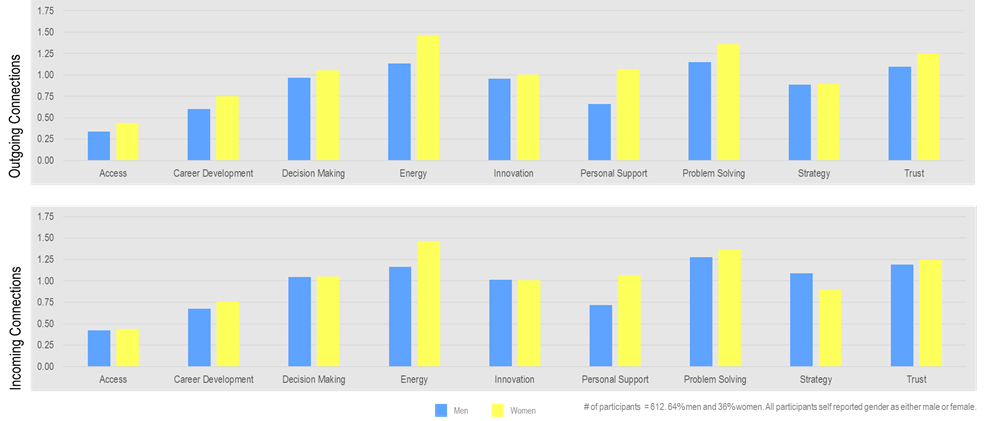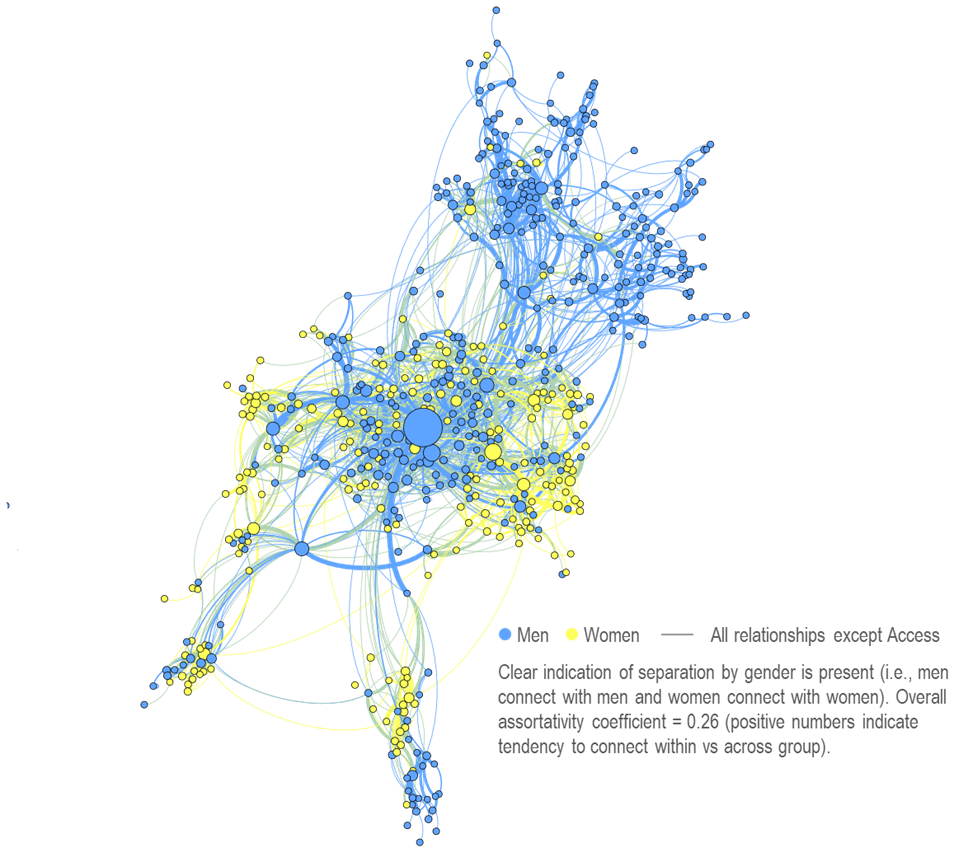In light of International Women’s Day, we’ve been thinking a lot about the amazing powers of women leaders and what makes them effective. Leadership is increasingly defined as a set of relationships, rather than a set of qualities or behaviors. Essentially, without people to lead, there is no leader. With this in mind, we were interested in how male and female leaders differ in the relationships they build and foster.
To this end, we analyzed the networks of close to 600 employees at a ~$2B life sciences company. From this study, we came away with two important findings. The first is that across levels, women were overall more relational than men. In other words, on average, women had more incoming and outgoing relationships than did their male counterparts. As you can see from Figure 1, this finding was true across multiple relationship types: trust (i.e., who has your back in a difficult situation at work), problem solving (i.e., who do you turn to for help solving difficult problems), decision-making (i.e., whose advice do you seek when making important decisions), etc. The one exception was in terms of strategy. Fewer people reported turning to women to discuss strategy. However, we believe this is largely a result of the disproportionate number of men at the top of the formal hierarchy where strategy conversations are largely concentrated.
Figure 1: Relationships by Gender

This finding, that women are more relational than men, suggests that women may be particularly well suited to lead in fast-paced, complex environments. Research clearly shows that the stronger a leader’s network, the more resilient they are (Cross et al., 2021). Those with more robust networks are better able to bounce back from setbacks because their supportive relationships bolster their abilities to manage stress, reframe challenges and feel a sense of purpose at work. As a result, woman may be better able to handle disruptive events.
Moreover, in the past, a leader’s influence and impact was largely determined by their position in the formal hierarchy. While a higher-level position still conveys greater influence, it is no longer the only thing that matters. In today’s fast-paced, complex environment, where leaders need to pull together and integrate cross-functional expertise outside the formal hierarchy, it is increasingly important for leaders to influence horizontally, across organizational silos. In this way, with broader, more diverse networks, women leaders are at an advantage when it comes to getting work done through others quickly and nimbly.
The second finding from our analysis was that women and men tend to cluster based on gender. Across all levels, men were significantly more likely to establish relationships with other men and women were more likely to establish relationships with other women (See Figure 2). This corroborates previous findings suggesting that people tend to connect with others they perceive as similar to themselves (Montoya et al., 2008). The challenge with this phenomenon is that, as noted, there are often more males at senior levels of the organization than females. As a result, women may have fewer opportunities to get mentored by senior executives, which we know is pivotal to how quickly an individual is promoted as well as how much they are compensated (Quast, 2008).
Figure 2: Organizational Network
The good news is that there are clear ways to help women get plugged into strategy discussions and find mentors and help men develop broader networks. And, organizations can accomplish both objectives with similar solutions. One way to do this is to create a structured mentoring across differences program, in which mentors and mentees are paired across gender boundaries. A second approach is to conduct Peer Learning Circles (PLCs), or small, facilitated cohorts of diverse leaders across an organization who learn from one another in a structured way. PLCs expand a leader’s network by nature, fostering natural relationships for male and female leaders alike. In separate research, we’ve found that PLCs can increase cross-enterprise networks by close to 500%. Finally, organizations can use platforms, such as Ten Thousand Coffees which automatically match employees based on individual and business objectives. Through the platform, underrepresented groups can be intentionally paired with leaders to grow their networks and give them valuable mentorship opportunities. By collecting participants’ goals and interests, the platform uses its Smart Matching technology to create connections and/or mentor/mentee matches. Whichever tactic is chosen, by creating a program that connects leaders across differences, organizations can drive gender equity and support leaders in building and optimizing the right networks to improve engagement and get work done.
References
Cross, R., Dillon, K., & Greenberg, D. (2021). “The secret to building resilience.” Harvard Business Review.
Montoya, R. M., Horton, R. S., & Kirchner, J. (2008). Is actual similarity necessary for attraction?
A meta-analysis of actual and perceived similarity. Journal of Social and Personal Relationships, 25(6), 889-922.
Quast, L. (2011). “How becoming a mentor can boost your career.” Forbes.
